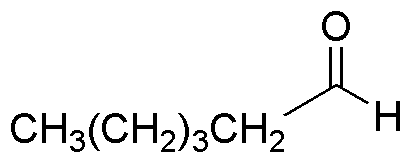Hexanal is widely utilized in research focused on:
- Flavor and Fragrance Industry: Hexanal is a key component in the formulation of flavors and fragrances, providing a green, fresh aroma that is often associated with fruits and vegetables. This makes it popular in food and cosmetic products.
- Agricultural Applications: It serves as an important intermediate in the synthesis of agrochemicals, including pesticides and herbicides, enhancing crop protection and yield.
- Chemical Synthesis: Hexanal is used as a building block in organic synthesis, enabling the production of various chemicals, including alcohols and acids, which are essential in many industrial processes.
- Biochemical Research: In studies related to lipid metabolism, hexanal is utilized as a model compound to investigate the effects of aldehydes on biological systems, providing insights into cellular responses and oxidative stress.
- Polymer Production: It is employed in the production of polymers and resins, contributing to the development of materials with specific properties, such as improved durability and resistance to environmental factors.
General Information
Properties
Safety and Regulations
Applications
Hexanal is widely utilized in research focused on:
- Flavor and Fragrance Industry: Hexanal is a key component in the formulation of flavors and fragrances, providing a green, fresh aroma that is often associated with fruits and vegetables. This makes it popular in food and cosmetic products.
- Agricultural Applications: It serves as an important intermediate in the synthesis of agrochemicals, including pesticides and herbicides, enhancing crop protection and yield.
- Chemical Synthesis: Hexanal is used as a building block in organic synthesis, enabling the production of various chemicals, including alcohols and acids, which are essential in many industrial processes.
- Biochemical Research: In studies related to lipid metabolism, hexanal is utilized as a model compound to investigate the effects of aldehydes on biological systems, providing insights into cellular responses and oxidative stress.
- Polymer Production: It is employed in the production of polymers and resins, contributing to the development of materials with specific properties, such as improved durability and resistance to environmental factors.
Documents
Safety Data Sheets (SDS)
The SDS provides comprehensive safety information on handling, storage, and disposal of the product.
Product Specification (PS)
The PS provides a comprehensive breakdown of the product’s properties, including chemical composition, physical state, purity, and storage requirements. It also details acceptable quality ranges and the product's intended applications.
Certificates of Analysis (COA)
Search for Certificates of Analysis (COA) by entering the products Lot Number. Lot and Batch Numbers can be found on a product’s label following the words ‘Lot’ or ‘Batch’.
*Catalog Number
*Lot Number
Certificates Of Origin (COO)
This COO confirms the country where the product was manufactured, and also details the materials and components used in it and whether it is derived from natural, synthetic, or other specific sources. This certificate may be required for customs, trade, and regulatory compliance.
*Catalog Number
*Lot Number
Safety Data Sheets (SDS)
The SDS provides comprehensive safety information on handling, storage, and disposal of the product.
DownloadProduct Specification (PS)
The PS provides a comprehensive breakdown of the product’s properties, including chemical composition, physical state, purity, and storage requirements. It also details acceptable quality ranges and the product's intended applications.
DownloadCertificates of Analysis (COA)
Search for Certificates of Analysis (COA) by entering the products Lot Number. Lot and Batch Numbers can be found on a product’s label following the words ‘Lot’ or ‘Batch’.
*Catalog Number
*Lot Number
Certificates Of Origin (COO)
This COO confirms the country where the product was manufactured, and also details the materials and components used in it and whether it is derived from natural, synthetic, or other specific sources. This certificate may be required for customs, trade, and regulatory compliance.

